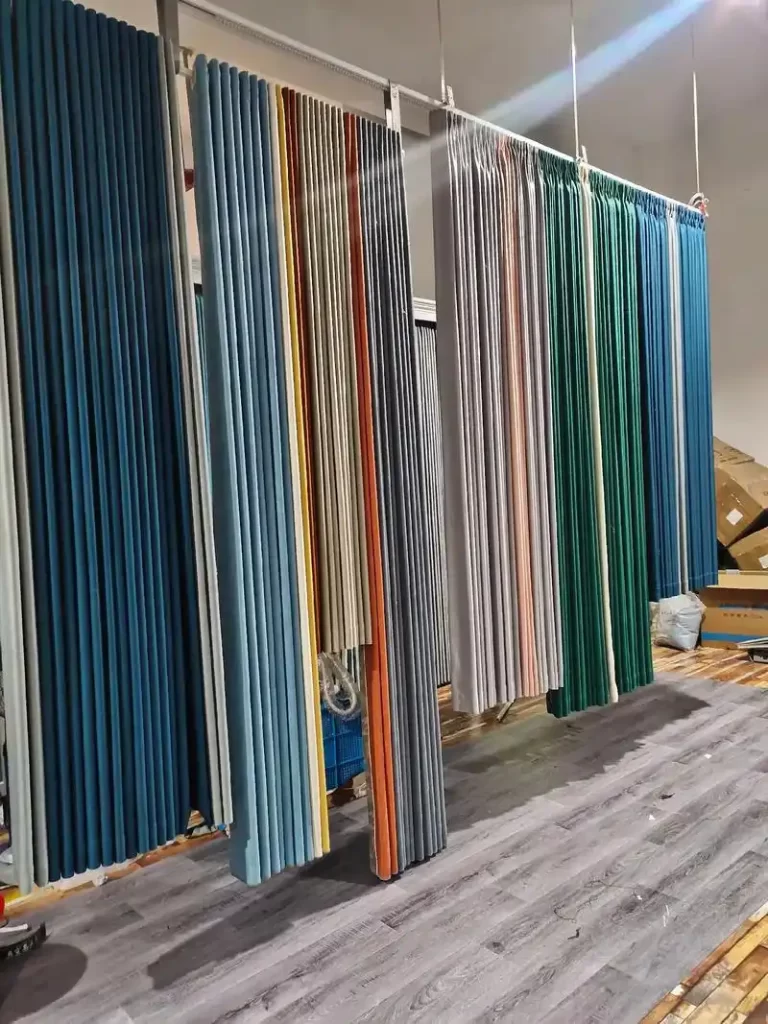
Windows That Whisper Your Name: The Art of Crafting Curtains That Feel Like Home
I’ve been working with curtains for as long as I can remember. Growing up in my family’s small textile workshop, I’d watch my mother hand-stitch ruffles onto curtains for neighbors, pausing to ask, “Will this softness make your mornings brighter?” or “Does this shade match the oak tree outside your window?” She’d say, “Curtains aren’t just cloth. They’re the quiet hello your space gives you—and the world—every day.” Today, as a curtain supplier carrying that legacy, I still believe those words. Every panel we craft is more than fabric; it’s a promise to honor your story, your needs, and your vision for the spaces you love.
It Starts With Listening—Not Measuring
Most curtain shopping trips begin with, “I need curtains for my living room.” Ours start with, “Tell me about your living room.”
Take Emma, a writer in a historic row house in Boston. “My windows face a busy street,” she said, flipping through fabric swatches. “I need quiet—both from noise and harsh light. But I hate curtains that feel heavy; my place is small, and I want it to feel airy.” Off-the-shelf blackout curtains? Too thick, swallowing her room. Sheer linens? Let in too much city clamor. So we dug deeper. Did she open the windows for fresh air? (Yes, even in winter, for the scent of pine from the park.) Did she have plants near the sill? (A spider plant that craved soft light.) Did she write at a desk by the window? (Late nights, needing focus.)
We chose a lightweight cotton-linen blend, woven with a tight enough weave to muffle street noise but loose enough to let in dappled daylight. We added a removable acoustic lining—thin, but dense enough to absorb echo—sewn discreetly behind the outer fabric. The hem? Extra-long, to pool on her hardwood floors, softening the room’s edges. When she hung them, she wrote: “Now I can hear the wind in the pines, not the cars. And my spider plant? It’s thriving. Thank you.”
That’s our rule: we measure the life around the window, not just the window itself. A kitchen needs stain-resistant fabric for splattered pasta sauce. A nursery needs breathable cotton for airflow (and a removable liner for midnight diaper changes). A home office needs sound-dampening layers to muffle traffic. These details aren’t add-ons—they’re the blueprint.
Fabric: Where Quality Becomes a Lifelong Partnership
I’ve seen clients cry over curtains that frayed after three washes or faded to a dull gray in one summer. Cheap fabric betrays you. That’s why we treat every bolt like it’s going into our own homes—and we back it up with care, not just claims.
Our fabric selection is deliberate:
-
Organic cotton: Soft, breathable, and grown without pesticides. We pre-wash it twice to shrink it before cutting, so it stays true to size wash after wash. Perfect for babies’ rooms or bedrooms where you want to breathe easy. A mom in Austin told us, “Your cotton curtains have survived 2 years of toddler hugs, crayon scribbles, and weekly washes—still soft as new.”
-
Belgian linen: It wrinkles, yes—but that’s its charm. Over time, it softens like a well-loved sweater, draping in that “effortlessly elegant” way no synthetic can. Ideal for living rooms or porches where “lived-in” charm beats stiffness.
-
Recycled PET blends: Made from plastic bottles, this fabric is tough enough for high-traffic areas (think restaurants or entryways) and dyed with non-toxic pigments that won’t bleed. A beachside café client raved, “Your curtains have survived sand, salt, and spill-prone kids—and they still look like the day we hung them.”
We also prioritize sustainability. Many of our fabrics carry OEKO-TEX® or GOTS certifications, meaning they’re free of harmful chemicals and produced ethically. A couple in Portland chose our organic cotton for their baby’s room: “We wanted something safe for her, and your fabrics checked every box—plus, they’re beautiful.”
The Craft: Details That Turn Curtains Into Heirlooms
Curtains look simple, but their magic lies in the invisible work: the stitching, the lining, the way they pool on the floor.
Every panel we make goes through 12 hands-on steps:
-
Laser-cut precision: No crooked edges—ever. Our machines measure to the millimeter, ensuring every panel matches perfectly.
-
French seams: Encasing raw threads to prevent fraying, even after years of use. (No one wants a curtain unraveling mid-drape!)
-
Weighted hems: Tiny linen strips sewn into the bottom to keep curtains pooling evenly, not bunching awkwardly.
-
Custom linings: For blackout or thermal curtains, we sew in separate lining pockets—so the outer fabric keeps its pattern, while the lining does the heavy lifting (blocking light, insulating heat).
Last year, we restored curtains for a 100-year-old farmhouse. The original panels were faded but beloved, with a hand-stitched floral border. We matched the fabric using century-old dye recipes, reinforced the seams, and added discreet Velcro tabs for easier cleaning. The owner, a grandmother, wept: “You didn’t just fix curtains—you brought my childhood home back to life.”
The Experience: Warm, Transparent, and Yours
Buying curtains shouldn’t feel like a chore. It should feel like collaborating with someone who cares as much about your space as you do.
-
No-pressure consultations: Swing by our studio, where bolts of fabric line the walls like a rainbow. Or hop on a video call—show me photos of your space, tell me about your cat (we’ll avoid white fabrics if he sheds!), or gush about the sunrise you want to frame. No clipboard, no hard feelings.
-
Samples that live with you: Wondering how a sage green linen curtain will look in your north-facing room? Hate the way a charcoal panel feels in person? We’ll mail you physical samples—with prepaid return labels—so you can test them for a week. A client in Chicago told us, “I kept your ivory cotton sample on my couch. It matched the afternoon light exactly how I imagined.”
-
Updates, not surprises: You’ll get photos of your curtains mid-production: the fabric being cut, the seams stitched, the final press. We’ll text when they’re loaded onto the truck and include a handwritten note—“These have been in our thoughts since our first chat. Hope they bring you as much joy as they did to our team.”
Curtains That Grow With You
The best window treatments aren’t static. They adapt—as your life changes, your style evolves, or your needs shift.
-
A young couple in Denver started with lightweight cotton curtains in their first apartment. Three years later, with a baby on the way, they called us to add blackout liners to the same panels. “We love the fabric—we just needed function,” they said. We reused the existing panels, adding a removable lining that zips on/off.
-
A boutique hotel in Sedona updated its lobby last year. They kept our original curtains (a desert-inspired print) but added motorized tracks for easier operation. “Guests still compliment the curtains—they’re part of the hotel’s identity,” the manager told us.
Why Partner With Us? Because We See Your Space as More Than a Room
Over the years, clients have become family. We’ve mourned with a family who lost a loved one and wanted curtains that felt “lighter” for their new home. We’ve celebrated with a couple whose startup succeeded—their first office curtains now hang in their CEO suite. We’ve even fixed a torn curtain tie for a bride whose wedding photos featured our panels (yes, we kept the spare!).
Being a curtain supplier isn’t about moving bolts of fabric. It’s about trusting that your windows deserve care, creativity, and a little bit of heart.
So whether you’re furnishing a dream home, refreshing a café, or reimagining an office, let’s create curtains that don’t just cover glass—they cradle the life inside.
Send us a message, swing by for a cup of tea, or share a photo of your space. We’d love to help your windows tell their story.
Article link:https://www.vlefooena.com/windows-that-whisper-your-name-the-art-of-crafting-curtains-that-feel-like-home

No reply content